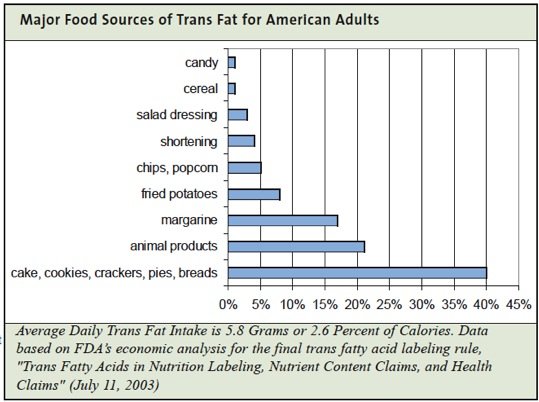Starting in January 2006 the US Food and Drug Administration (FDA) started requiring food labels to add the amount of trans fatty acids to the label. Research has shown that the consumption of trans fatty acids from partially hydrogenated vegetable oils was associated with higher LDL-cholesterol levels and lower levels of HDL-cholesterol.
Other research has shown people who consumed more trans fatty acids were more likely to die from coronary artery disease. The new labeling requirement combined with a news media blitz about the adverse effects of partially hydrogenated oils has led to the ban of partially hydrogenated oils in restaurants in a growing number of cities and states.
However, while it is clear that partially hydrogenated oils and at least some of their trans fatty acids have adverse metabolic effects that contribute to more heart attacks and cardiac deaths, it is increasingly clear that not all trans fatty acids are equally bad for your heart. Indeed, preliminary research suggests some trans fatty acids may actually cut the risk of heart disease or coronary artery disease (CAD).There are different types of polyunsaturated fatty acids and saturated fatty acids that have very different effects on blood lipids, inflammation, blood clotting, and other known and suspected cardiovascular disease risk factors. It should not be all that surprising that not all trans fatty acids have the same impact on the risk of CAD.Shortly after the FDA?s labeling requirement went into effect, researchers at Washington University published data from a case-controlled study, which examined the amounts of different types trans fatty acids in the membranes of red blood cells of 214 people who had suffered a fatal heart attack with age-matched control subjects.What they found was that the most common type of trans fatty acid (trans-18:1) produced by hydrogenating oils was actually associated with a reduced risk of death from heart disease. By contrast, the researchers observed more death from CAD with higher levels of another less common trans fatty acid (trans 18:2).1 Indeed, in both this study and an earlier study with younger subjects these researchers observed about a 4-fold increased risk of sudden cardiac deaths in the people who had the most trans-18:2 versus the least in their cell membranes. They speculated that the trans-18:2 polyunsaturated fatty acid might be displacing the natural cis bonded polyunsaturated fatty in the heart muscle cell?s membranes. This could increase the risk of a fatal arrhythmia due to alteration of the membrane?s ability to maintain an electrolyte balance within the heart?s cells, thereby increasing the risk of a fatal ventricular fibrillation during a heart attack.Unfortunately there is little correlation between the amount of the possibly ?good? trans-18-1,which is easily converted to conjugated linolenic acid that appears protective and the ?bad? trans-18:2 fatty acids. Turns out trans-18:2 are produced when vegetable oils are deodorized and when vegetable oils are used in frying. Small amounts of trans-18:2 also occur in dairy fat. However, these foods would not be labeled as having trans fat. By contrast, the ?good? trans-18:1 is produced by partial hydrogenation but very little is found in refined oils or dairy fat. If other research confirms these findings it will be a lot more difficult for consumers to avoid the really harmful trans fatty acids because the food labels won?t differentiate between the different type of trans fatty acids.
Bottom Line:Until we know more it may be best to limit the use of most refined oils, dairy fat, and cut back on the use of deep fried foods whether or not the oil they were fried in was hydrogenated.For more information on diet and heart disease, visit online at foodandhealth.com then CPE courses and go to the Diet and Heart Disease Topics.By James J. Kenney, PhD, RD, FACNReference:1. Circulation 2006;114:209-15



